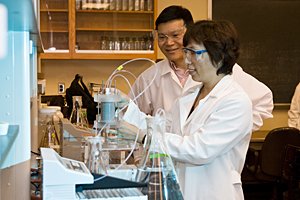Aug 28 2009
Two University of Delaware faculty members have been awarded $330,000 from the National Science Foundation to conduct a theoretical and experimental study of the transport and retention of nanoparticles through subsurface porous media.
 Lian-Ping Wang, left, and Yan Jin have received a National Science Foundation grant to study nanoparticle transport.
Lian-Ping Wang, left, and Yan Jin have received a National Science Foundation grant to study nanoparticle transport.
The 30-month project will be led by Lian-Ping Wang, professor in the Department of Mechanical Engineering, with a joint appointment in the College of Earth, Ocean, and Environment, and Yan Jin, professor in the Department of Plant and Soil Sciences, with a joint appointment in the Department of Civil and Environmental Engineering.
While engineered nanomaterials are being widely used in applications ranging from medicine to environmental cleanup, little is known about their environmental, health, and safety implications.
“It's becoming increasingly important to assess the environmental implications of nanoparticle release, including the potential impact on species within aquatic ecosystems,” Jin says. “Many regulatory organizations are struggling to identify how to assess the potential environmental impacts associated with nanomaterials, as they exhibit properties that are distinct from their larger counterparts.”
Wang and Jin plan to develop an experimentally validated, mechanistic simulation approach that can connect micro- to nanoscale phenomena to a centimeter scale retention profile. The resulting simulation tool will eventually be used to guide the design of better experiments for studying nanoparticle retention in natural soil. The researchers will focus on addressing questions related to the effects of size and aggregation on nanoparticle transport.
They will use computational tools to simulate flow field within porous soils and to track nanoparticle movement and interaction with soil-grain surfaces. In parallel, they will measure the transport of silica and magnetite nanoparticles in model sand media. These results will then be used to develop a better understanding of hydrodynamic forces and physicochemical interactions as well as to guide scale-up of the observations made in the model experimental systems.
“The work will provide us with insight into how size, aggregate shape, and surface chemistry play a role in nanomaterial-soil interactions,” Wang says. “It will also help us foresee the potential risks of nanomaterials and explore ways to minimize these risks to human and ecosystem health.”
This new project builds on the ongoing collaboration that Wang and Jin initiated in 2006 with funding from the U.S. Department of Agriculture. They have received two grants totaling $340,000 from the USDA over the past three years.
Jin and Wang believe the main reason for their continued success in securing research funding is the rather unconventional nature of their collaboration. “We have very complementary strengths,” says Jin. “We really benefit from each other's knowledge, and so do our students.”
Their joint work is now being published in journals covering engineering fluid mechanics, environmental engineering and science, and soil science.
Jin is an experimentalist whose area of expertise is environmental soil physics, while Wang's work, which focuses on multiphase fluid mechanics, is more theoretical. He has been motivated by Jin to improve the computational tools that he has developed because, he says, “She presents very interesting problems, and the computational tools we had aren't advanced enough to solve them.”
Their recent collaborations have provided Wang and Jin with new research tools and new insights into the transport of colloidal particles. “But the big unknown is whether nanoparticles behave similarly to their larger counterparts,” Jin says.